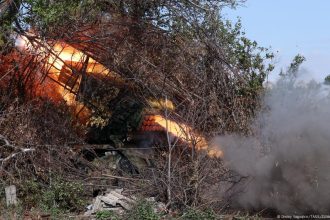Typhoon Kalmaegi brought torrential rain and strong winds as it hurtled into central Philippines on Tuesday killing more than 40 people, officials said.
The number includes the six crew members of a military helicopter that crashed in Mindanao, while conducting a humanitarian disaster response mission.
The island of Cebu was hit the hardest. According to local authorities, 39 people died from drowning or falling debris there.
Rescue teams work to evacuate stranded residentsImage: Alan Tangcawan/AFP/Getty Images
What do we know about Typhoon Kalmaegi?
The typhoon, locally known as Tino, made landfall around midnight in the eastern province of Southern Leyte and also hit Cebu, where residents were still reeling from a powerful earthquake that struck the province last month.
The typhoon had sustained winds of up to 140 kilometers (87 miles) per hour and gusts of up to 195 kph (121 mph) as of Monday afternoon.
Typhoon Kalmaegi ravages Philippines as toll climbs
To view this video please enable JavaScript, and consider upgrading to a web browser that supports HTML5 video
Kalmaegi is forecast to move across the Visayas Islands region and out over the South China Sea by Wednesday.
The Vietnamese government also said Tuesday it was preparing for the worst-case scenario as it braced for the impact of Kalmaegi.
Thousands of residents evacuated, many trapped on rooftops
Gwendolyn Pang, secretary-general of the Philippine Red Cross, said people were trapped on their roofs by floodwaters in the coastal town of Liloan in Cebu province.
In Cebu’s city of Mandaue, floodwaters reached “up to the level of heads of people,” she said, adding that several cars were either submerged in floodwater or floated in another Cebu community.
More than 160 flights to and from affected areas were canceled. Those at sea were advised to head to the nearest safe harbor immediately and stay in port.
People carry their pets to safer ground in CebuImage: Jacqueline Hernandez/AP Photo/dpa/picture alliance
The weather bureau PAGASA warned of a high risk of “life-threatening and damaging storm surges” that could reach over 3 meters high along coastal and low-lying communities in central Philippines, including parts of Mindanao.
Scientists have linked amplified climate change with rising changing ocean temperatures and intensification of stormsas well as other extreme weather events.
Edited by: Rana Taha


















